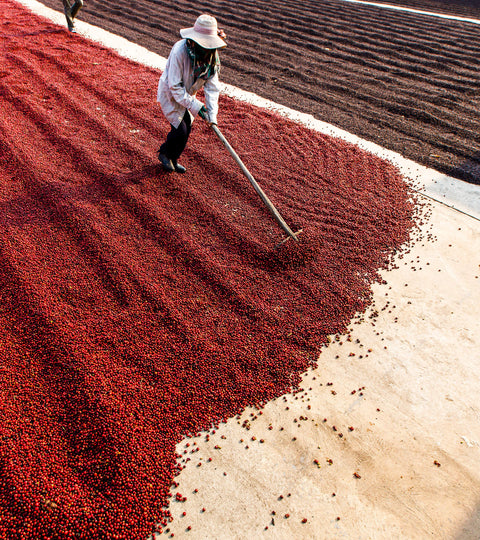Different Ways To Process Coffee And Why It Matters
Wet hulled, honey, natural—these are a few of the ways that coffee is processed. But what exactly do these coffee processing methods entail? And, furthermore, does it really matter in terms of quality, taste, and all the other factors you use to judge your cup of java?
In a word: yes!
While there are numerous variations and new techniques, there are five common coffee processing methods. We’ll be giving you a jump start into this exciting topic with the information you need to make educated choices before you grab your next cup of joe.

Natural Processing
You can consider this approach the “old reliable” since it was the first coffee processing method and remains popular to this day. Natural processing is ideal for locations that are sunny, dry, and warm. Although it is most frequently used in Ethiopia, Brazil, and Yemen, natural processing is common in all coffee-producing regions. Coffee produced through this approach tends to be winey and fruity.Steps of the Process:
- First, the coffee cherries are picked.
- Then, the cherries are sent to a washing station and selected for quality (i.e. ripeness, freshness).
- After being sorted and weighed, they are moved to a drying area. There, the coffee cherries can remain for up to three to four weeks until they reach a moisture content of around 11%. It’s important to note that the seeds are not removed from the fruit during drying.
- The coffee cherries are then transferred to a dry mill, where a hulling machine removes the fruit and its parchment layer.
- Lastly, the coffee is sorted, placed in sacks, and shipped.
Washed Processing
The washed processing method was developed in the Caribbean during the 1850s; it became widely adopted because of its effectiveness when dealing with large quantities of coffee. Washed processing is now used throughout its home region, and also Central America, South America, and Africa. It’s an excellent choice for regions with lots of sunlight during the day and cooler overnight temperatures. Coffees produced using washed processing tend to have floral and sour profiles and also a citrusy flavor.Steps of the Process:
- First, the coffee fruit is harvested when ripe.
- Second, it’s weighed, washed, and sorted for quality.
- Then, the coffee fruit is run through a depulper (a machine that removes the seed from the pulp).
- Shortly thereafter, the seeds are transferred to a fermentation tank to make removing the mucilage easier.
- The next day, after checking to ensure that the mucilage has fermented enough, the coffee is submerged and agitated to remove the mucilage.
- Afterwards, the coffee is moved to a drying surface and spread out, being raked numerous times per day to ensure even drying until it reaches a moisture level of 11%. This can take up to two weeks.
- Lastly, the coffee is transferred with its parchment layer intact into a storage area. The parchment layers are removed before the coffee is shipped out.
Wet-Hulled Processing
Wet-hulled processing is an Indonesian staple, one that is rarely used elsewhere. This method is well-suited for regions that are extremely humid, damp, and cloudy. Coffee produced using this approach tends to have a musty and herb-like flavor profile, yet also have a natural heaviness and chocolatey taste. The main differentiating factor of this method is the fact that the parchment layer is removed from the seeds, allowing them to dry faster, save time and space, and be better preserved.Steps of the Process:
- First, the fruit is immediately depulped.
- Then, while still in their mucilage, the seeds are transported into a fermentation tank where they will remain overnight.
- Afterwards, the coffee is given a pre-dry until it reaches approximately 30-35% moisture.
- At that moisture level, the seeds are transported to a wet-hull machine, where the parchment layer is removed from the seeds.
- Lastly, the coffee is dried until it reaches around an 11-12% moisture level and is then readied for shipping.
Honey Processing
This is a relatively new process, having been developed in the 1990s. Although devised in Brazil, it has gained its widest adoption in Costa Rica as a response to national regulations designed to conserve water; honey processing is generally popular throughout Central America. Coffee produced using the honey process tends to have a fruity taste, but a variety of flavor profiles do occur. One of the fascinating aspects about honey-processed coffee is that it can resemble a natural-processed coffee if more mucilage is left on and a washed-processed coffee if more mucilage is removed.

Steps of the Process:
- First, the coffee fruit is picked when ripe and sorted for quality.
- Eight to twelve hours later, the coffee is depulped.
- Then, the depulped coffee is transferred to a drying area, where it will remain for two to three weeks until it reaches an 11% moisture level.
- The coffee is sometimes also piled in a greenhouse and agitated, rotated, aerated, and raked out.
- Lastly, the coffee is transferred with its parchment layer intact to a warehouse. The parchment layer is removed before it is shipped off.
Mechanically Demucilaged Processing
We’ll keep this one brief: The major difference between mechanically demucilaged coffee and honey coffee is that the former has passed through a demucilator. A demucilator uses small quantities of water to remove mucilage.Why Do Coffee Processing Methods Matter?
The primary reason why you may want to pay attention to how your coffee is processed is because these distinct methods produce different flavor profiles.We recommend that you experiment to find which coffee tastes best for your unique palate. If you’d like to make your quest to find the best coffee much simpler, consider one of Goldleaf’s easy to use and informative Coffee Journals.
Conclusion
Discovering the coffee processing method behind your favorite coffee is simple. Most specialty and third wave coffee roasters have that information labeled on their bags; some even include it in their product titles. And quality coffee shops will gladly supply that information to customers upon request.If you’ve followed us for any length of time, you know that Goldleaf is a leader in sharing accurate information on the science behind cannabis. But how similar is cannabis to coffee? Find out more about the similarities between these two botanicals by reading our article on the topic.
Additional Research & Sources:
Dancing Goats Coffee. (n.d.) Processing coffee. https://www.dancinggoats.com/pages/processing-coffeeReiland, Andy & Meister, Ever. [Cafe Imports]. (2019, June 6). Honey coffee processing [Video]. YouTube. https://www.youtube.com/watch?v=k5iw31z1FAY
Reiland, Andy & Meister, Ever. [Cafe Imports]. (2019, June 5). Natural coffee processing [Video]. YouTube. https://www.youtube.com/watch?v=yagagM7SlWs
Reiland, Andy & Meister, Ever. [Cafe Imports]. (2019, June 3). Washed coffee processing [Video]. YouTube. https://www.youtube.com/watch?v=Az0W61hotLM
Reiland, Andy & Meister, Ever. [Cafe Imports]. (2019, June 4). Wet-hulled coffee processing [Video]. YouTube.
https://www.youtube.com/watch?v=R1z4omBqYxQ&list=RDCMUCT4Fu4eGQbDpmZHPNKOQLSQ&index=11
Sage, Emma. [Coffee Quality Institute]. (2020, May 8). Lessons in coffee processing - processing methods comparison [Video]. YouTube.
https://www.youtube.com/watch?v=NCrNSaoDhBo

